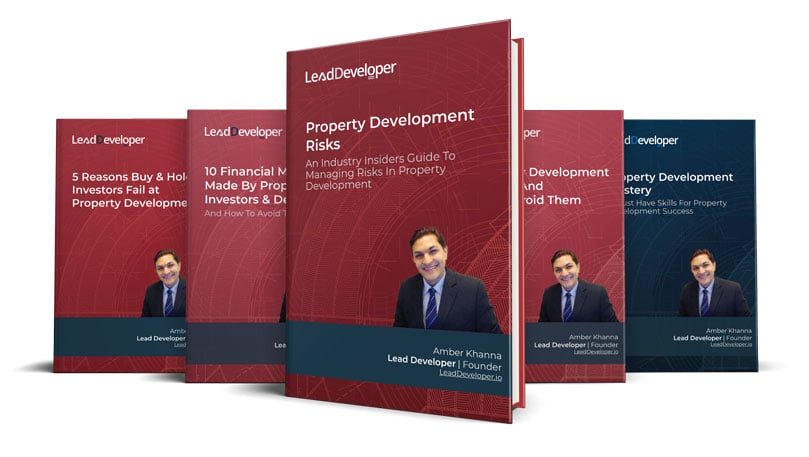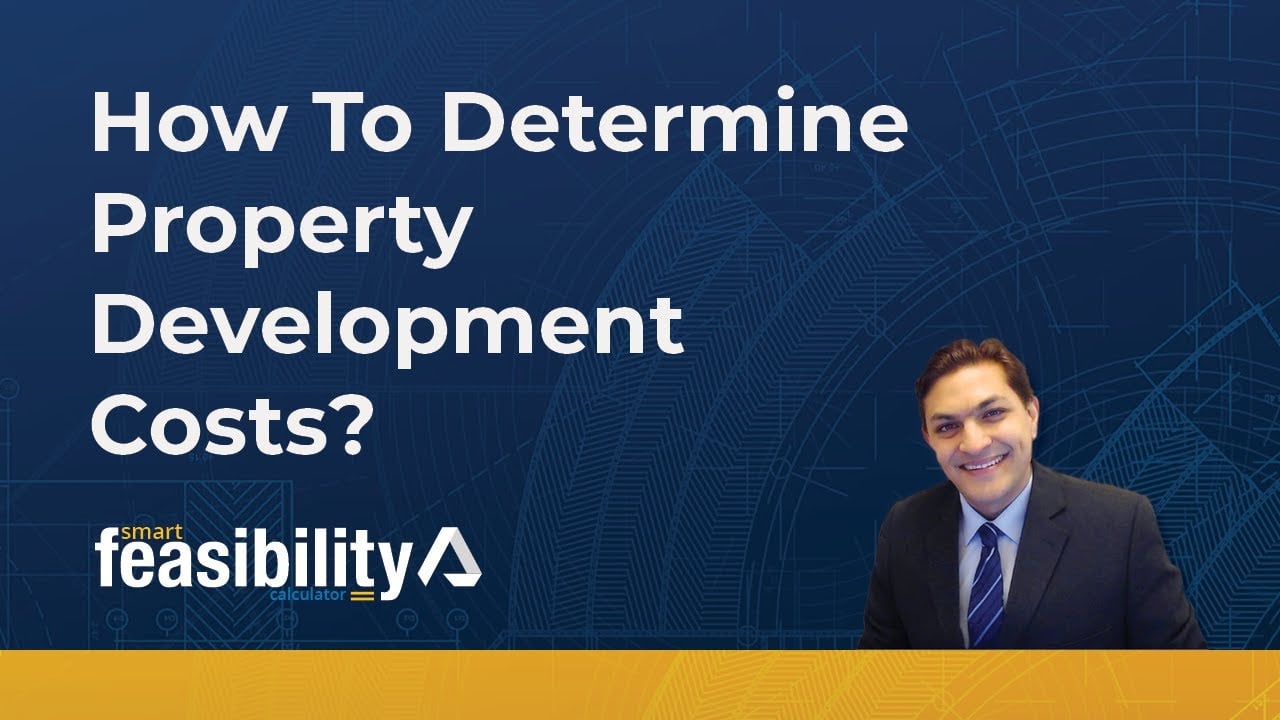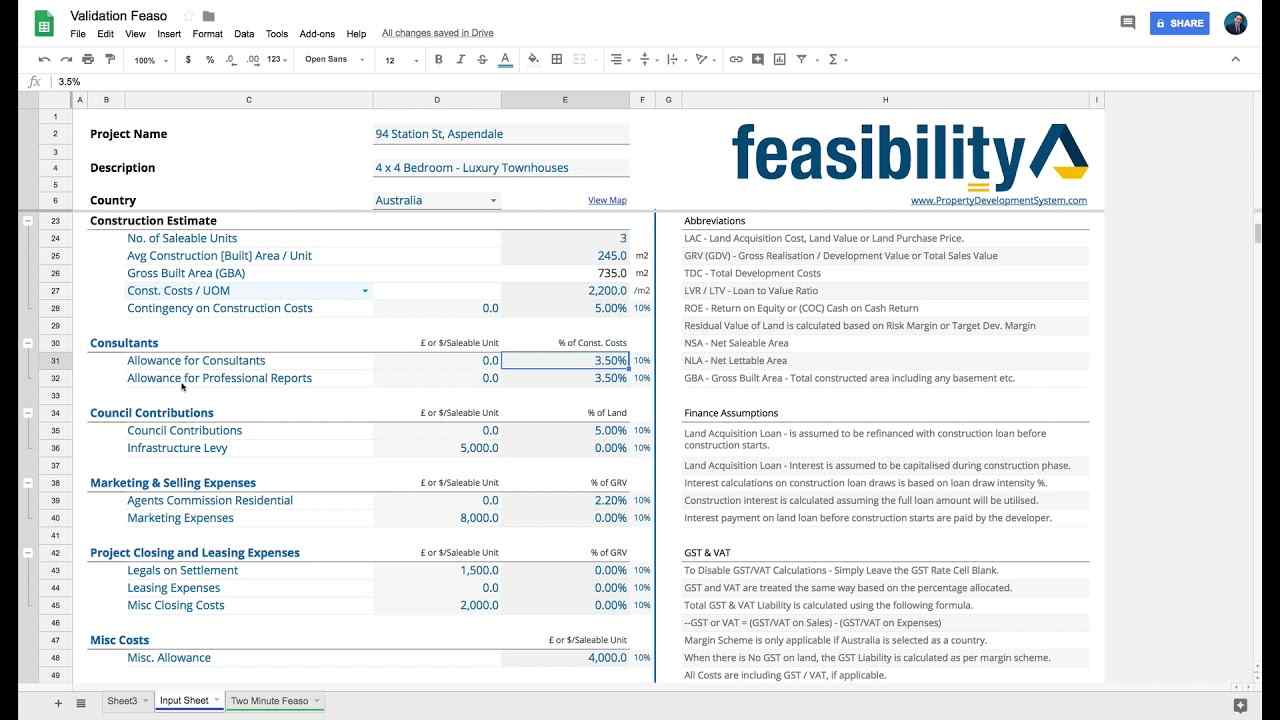How To Manage Risks In Property Development?
Becoming a property developer comes with inherent risks. To become a successful property developer, one needs to manage the risks in property development. A sound Property Development Feasibility Study offers the opportunity to analyse, identify, mitigate and or avoid significant risks at preliminary stages.
I want to stress that ANY investment or wealth creation vehicle should have a sound strategy and execution behind it. Moreover, when any of these things are lacking, the risks go up. Also, these risks are not limited to property development, which is just one of the many property investment strategies.
I firmly believe unmanaged, or what I like to call ‘HOPE Property Development’ is risky. However, property development, managed via a proven system, should be well within anyone’s comfort level.
A property developer’s success depends upon being proactive to recognise and deal with these risks.
Real Estate Markets Have A Component Of Risk And Uncertainty
A Real Estate Development is based on the expectation of a future demand which comes with risk and uncertainty.
To be a successful property developer, you must become astute at getting your development to the market at the right time and the right price. The development profits depend on how you manage your development costs across your timeline against the gross value of your development at the end of your project.
Property development requires a reasonably large amount of capital & a dedicated development team of professionals with different skill sets to coordinate a wide range of interdependent tasks.
You are essentially juggling between:
- legal requirements
- local authorities
- immediate neighbours & residents
- managing consultants and contractors
- managing expectations of project stakeholders, investors & prospective buyers and or tenants, as well as adhering to project timelines & monitoring property development costs and contingencies.
Learn More
How To Determine Property Development Costs?
How To Estimate Consultants And Other Costs?
In addition to that, becoming a property developer requires facing the following external challenges:
- Environmental and Technological conditions
- Economic instability
- Social Issues
- Urban & Planning issues
- Political factors
- Legal Contracts
- Addressing council regulations as well as changes to land rezoning, just because one politician thinks it would help them win the election. (True Story – recently happened in Melbourne).
Managing Risks In Property Development
A thought out risk management approach is critical in becoming a successful property developer. A sound risk management approach, may not matter as much during a booming market and periods of strong economic growth, but it becomes critical when conditions unfavourable.
The more you are aware of the risks in your development project, the more you would come across as a credible development manager. When discussing various project risks with your stakeholders, whether it’s your lender, local authorities, or prospective investor & or buyer, you as a developer must assure them that adequate risk management strategies have been thought of and included in your development proposal.
Success in real estate development or joint venture investments will depend to a great extent on sound assumptions regarding risk factors taken into account.
Your aim as a real estate developer is to recognize potential development opportunities where you can increase and or add value to land for future cash flows by optimizing land to its highest best value.
The highest best possible use of land includes increasing and or improving the land use by either, sub-diving, building townhouses, apartment or by turning a building into a leasable space.
The developer’s role is that of an entrepreneur whereby they identify and make the best use of the land.
As a property developer you have to focus on the satisfaction of the needs of both, prospective buyers and the investors and at the same time ensure that your project is profitable.
Risk Factors In Property Development
Location Location Location
One of the significant constraints of a block of land & or real estate is that it’s tied to its location. It is scarce and & has limited substitutability. Different suburbs and different property categories within a suburb perform differently. If there’s an excess of a particular type of property for a specific suburb coupled with reduced buyer demand, it will have an impact on selling prices as some parts of a market will perform better, and some will play much worse. As a property developer, you select your block of land with development potential.
Time Bound
Real estate development is highly complex, fast-changing and multi-disciplinary. The time it takes from start to finish of the development process, and the complexity involves a considerable amount of time and, as a result, real estate developers lack the flexibility to respond and adjust quickly to any fluctuations in the market, which results in increased financial risk.
Investment
The construction of real estate and the acquiring the property requires a considerable investment. Also, a developer needs to ensure a maximum return on equity, most often external funds are also necessary to cover capital needs. That makes the development industry and capital markets closely interrelated.
Planning And Council Regulations
The real estate market is mostly open, generally available market. However, the government also exerts its influence through social and tax policy in the form of rent regulations, tax deductions & depreciation allowances, stamp duty and more directly by setting planning policy frameworks.
Property Market Cycles
The property markets experiences cycles, and a developer needs to make sure he has a strategic plan and conducted a sound market analysis. Risk assessment and management becomes extremely important during all phases of the market cycle or property clock.
Because of the long time a development project takes, there is always a possibility that the completed development gets delivered to the market in a downturn.
A developer must be ready with a strategy and plan to make during such market downturns -Its a critical risk management tool.
The Real Estate Development Process And Related Risks
There is a high level of uncertainty during the early stages of a project, at the same time many business decisions have to be taken. These decisions have a significant impact on the success of the project. It is therefore imperative that potential risks be identified, assessed and allowed for at the outset of any project.
Project Inception Stage Risks
The process begins with Identifying the future demand and provide an adequate supply and create value. The developer needs to use their creativity and drive for a projects’ success.
Project Timing Risk (Starting And Delivering The Development)
The project’s timing is a critical success factor in this context, which depends on the one hand on project-specific market conditions (tenant and selling market) and the relevant market cycle and the availability of attractive land plots.
How To Manage Project Timing In Property Development?
The developer has to identify these market opportunities diligently. Carry out specific market research to ascertain demand from potential users/tenants and possible investor profiles for the proposed development
As a property developer, you should never enter into an unconditional purchase acquisition before conducting a full-scale Property Development Feasibility Study. Instead, at this stage try and ensure exclusivity with the landowner. A property option agreement or a purchase subject to conditions criteria are possible routes to achieve this.
In the case of an unsatisfying outcome of the concept and its fundamental economics, the project will likely not proceed further. At this stage, the thorough research can help in avoiding financial losses at a later stage.
You are missing out if you haven't yet subscribed to our YouTube Channel
Pre-Construction Risks
After the initial process, if the project looks viable, the next phase in the development process starts with the project feasibility analysis. In case the project in numbers stacks up the developer would look at taking the implementation decisions, if not its best to abandon the project. This phase is one of the most crucial aspects of the development process given its effect on project decision-making by the developer.
Market Risk
In a development project, the most critical point to consider is what do the buyers want?
How readily will the project get absorbed by the market at the rent and property values applicable?
Before you commit to the funds in a development project, a developer, as well as his stakeholders and financing partners, need to make sure that market will support the values assumed in the project appraisal.
How To Manage Market Risk In Property Development?
The due diligence and feasibility analysis are based on detailed market and location study, building code reviews, design studies, use analysis, risk assessments, competitive analyses as well as profitability calculations.

Planning Approval Risk
Every development is subject to planning approval from local councils. Moreover, developers, in general, apply for permissions that are in line with official planning rules and residential zoning. However, it is also possible that local councils can reject or delay the planning application. Such delays can reduce project profit by increasing the project timeline. Such delays have a direct impact on project timelines.
Managing Planning Approval Risk
Understanding how certain councils operate and their requirements. In case the project size is big, or it’s a complex development, developers can consider approaching the planning authorities for an initial view of the proposed development. Involved architects and planning consultants typically take the lead when liaising with the planning authorities. Once again having a strategy in place to address any issues that may arise during the planning stage is very important. It would be best if you considered buying a site with Development Approval or permit in place. .Obtaining approvals as needed, confirm the basis of contributions, purchase conditional on rezoning, active liaison with Council to name a few. The approval process should be managed efficiently to minimise this risk. Sometimes an exit strategy could be the best option.
Experience Risk
Experience Risk is based on the experience or knowledge of the developer. In case you are a first-time developer/builder or someone developing a different type of development, your ability and know how to manage the project might not be the same as an experienced and seasoned developer.
How To Manage The Developer’s Inexperience Risk?
Make sure you only deal with experienced developers and builders, investigate track record of successful developments, avoid one-off and or experimental development projects. Educate yourself and learn from experienced professionals before you go unconditional on the contract of sale. Hire a professional or a qualified person to manage your projects. Do not rush into a project without carefully considering the extent and impact of your development.
Read More: How to Prepare for Property Development?
Get The Edge Now!
Discover the transformative power of our FREE EDGE platform and
unlock a world of opportunities at no cost!

Your Real Estate Toolkit Awaits!
Free eBooks, Courses & Feasibility Suite Trial—Join Today!
✓ Unlimited FREE Trial: Experience the full power of our Feasibility Suite with hands-on demos
—explore without limits, no time pressure & without commitment or credit card!
✓ Learn from Success: Dive into real-life case studies for practical insights.
✓ Engage, Inquire, and Innovate: Ask questions, request features, and engage in lively discussions.
✓ Showcase Your Projects and Gain Insights: Share your projects and get personalised feedback.
✓ Free Resources Galore: Access a treasure trove of free resources,
eBooks & courses to keep you informed.
✓ Exclusive Training: Enjoy members-only training to sharpen your skills.
Profit And Feasibility Risk
The developer needs to calculate a detailed Feasibility analysis. The profitability of a development project gets affected by short-term interest rates, building cost, rental values and investment yield. Rental values get determined by the demand and supply of land and investment yield is driven by capital market perceptions of real estate and the evaluation of the project. The maturity and liquidity of property markets is a crucial factor for investors to study the markets and projects correctly. Making assumptions based on reliable data, financial performance benchmarks, doing a risk analysis.
Become A Financial Feasibility Pro
Property Development Financial Feasibility should be used to define the results of the project’s return clearly. Developer needs to calculate the following the net income to pay off the debt, operating costs (i.e. break-even analysis), net cash flow after debt service to provide adequate risk-adjusted returns on equity, net present value of returns to exceed project cost, and NPV (Net Present Value) analysis to cover construction, absorption and operations periods. It is also vital to understand your end user who will buy your finished product. It will help if you must have a very disciplined approach, reject projects which are marginal and do not meet benchmarks. Making assumptions based on reliable data, financial performance benchmarks, doing a complete risk analysis.
Financing Risk
Developers have to obtain property development finance at terms favourable to them, to cover the entire duration of their development. Thus finding the right finance partner and best suitable financial conditions are both crucial to the success of the project.
Interest rates and financing conditions significantly affect developers as few projects are entirely equity financed, the availability and cost of debt financing have a significant impact on the overall project profitability and feasibility.
Increasing interest rates also improve the overall costs of the project, thus reducing profits of the project.
Also, time and finance risk are related risks in the sense that delays in the project will also increase the financial risk as interest rates may go up during that time and the additional time needed for completion will add interest cost on the debt financing required.
How To Manage Finance And Interest Rate Risk?
If you want to reduce financial risk, it is advisable to avoid financial commitment to a project before completion of the final development feasibility analysis and a decision to implement. The developer may hedge interest rates and use strategic alliances to introduce joint venture and mezzanine finance options, thus reducing the need for outright loan financing. To secure finance at an affordable interest rate, you must perform, document & present the preliminary feasibility analyses to potential lenders.
Construction Costs Risk
Cost Risk is closely related to time & construction risk, as the time needed for real estate development to be completed leads in cost factors to vary and reduces the reliability of cost forecasts that form the basis of your development feasibility. A sudden increase in prices or tax levies can increase the overall costs and eat into your profit. Cost risk is affected by all the above risks.
How To Manage Costs Blowouts In Property Development?
Thorough management of the project, in line with due diligence and financial feasibility, is especially crucial for effective cost control. Using a reliable builder is very important. Also, Fixed price building contracts and agreements are the best way for a developer to ensure that your development continues smoothly.
Building Site Risk
What if the selected site is unsuitable, or needs to be modified to become suitable (which would involve further costs).Like in case we might need to alter the land for our development due to environmental issues (such as contamination) or its natural characteristics (stability, water levels, subsidence.).
Managing Site Risk
To minimise building site risk appropriate external technical and engineering due diligence is to be sought and acquisition contracts drafted to retain a right of redress if the site does not meet expected criteria. Engaging expert consultants, analysing cost impacts before committing, making contracts conditional on resolving issues.
Time Risk
Exceeding the planned project timeline leads to two main risks:
- Cost of capital i.e. the interest could increase due to delays reducing project returns, and
- Market conditions could change over time reducing the reliability of forecast data. Market conditions are relevant for developers as they cause delays in the completion of such projects and can increase losses.
Managing Time Risk
Time risk can be managed by addressing the following:
- Practising project management best practices
- Clear documentation
- Coordination and communication between project parties & stakeholders and selection of an experienced and qualified property development team.
- Using an experienced project manager and or a property mentor for your first development will minimise some of these risks, but it’s still essential to do as much due diligence on the location, property, council requirements and contractors/builders they will be relying on to ensure a successful property developer.
- Communication amongst the team is vital as friction occurs when one party can’t get an answer back from another party promptly and timely commencement of marketing. An overall understanding of market forces and dynamics is also critical.
Property Development Risk
Is the risk that the leasing or sale of the project will not generate sufficient returns to cover the cost or will not create the desired performance due to a lack of sales, or not meet the needs of the market concerning type and location, or there is a property downturn.
3 Ways To Manage Risks In Property Development
- Assess & ascertain developer’s abilities – do they have the necessary skill and experience for the type of development they are about to undertake
- A systematic and comprehensive feasibility study analysis
- Securing Pre-Sales & timing the marketing of the project.
Sales Risks
Following are some of the Sales and or Post Construction Risks in Property Development:
- The timing of delivering development (cycle risk),
- Changes in market value and capitalisation rates,
- Unfavourable changes in demand and supply,
- Leases/sales pre-commitments fail to complete,
- Incorrect branding and image,
- Market positioning & developer’s image.
How To Manage Sales & Marketing Risk In Property Development?
There’s no way to pick the optimum time in the market. However, for property developers, it doesn’t matter what stage the property market cycle is at, as long as their research and due diligence are stringent enough to pick the right areas to develop based on their supply & demand analysis for the specific suburb.
As a property developer and a project manager of your development, you must research the property market based on the 7 Key Property Market Economic Indicators that give property developers an edge & the ability to continue property development in all market cycles. These Economic Indicators enable them to secure projects in the right areas. Areas where new infrastructure is planned, and demand along with population growth and employment, is growing.
Four Steps To Manage Risk In Property Development
As a project progresses, the types and nature of risks may change, and new threats may emerge, and existing risks may vary in their importance. Identifying and managing risks is an ongoing activity throughout the duration of your project.
You as a skilled property developer you must be able to identify risks, peg them against a dollar value and allow for them in your feasibility analysis. Project costs, as per your feasibility study will determine your strategy when dealing with development risk. You can then take four critical steps to manage risk in property development.
- Avoid the risk
- Contain the risk
- Minimise the risk and or
- Transfer the risk
Four Reasons You Must Have A Buffer Amount (Cash) To Fund Your Development
- Interest Rate Hikes
- Market downturn
- Project Delays &
- Cost Variations
MEGA DEVELOPMENT COSTS CHECKLISTS
End-To-End Property Development Cost Checklists
Includes both hard and soft costs, as well as detailed residential construction & renovation costs, so you never miss anything.
Conclusion
Being Risk Averse and conducting your Due Diligence and financial feasibility right from project inception is highly essential for anyone who wants to become a successful property developer. Investing the right education and taking property development courses is critical for your success to become a property developer. Checkout our Ultimate Guide To Getting Started In Property Development.


